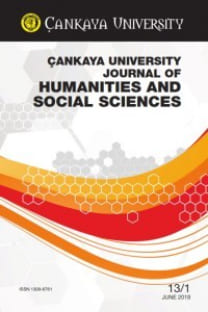Rabbit Hole ve Clybourne Park’ta Ev Alanı ve Yeni Aile Kavramları
Amerikan Dramı, tiyatro, aile dramları, Rabbit Hole, Clybourne Park
Concepts of Domestic Space and the New Family in Rabbit Hole and Clybourne Park
American Drama, Theatre, Domestic Drama, Rabbit Hole, Clybourne Park,
___
- Berkowitz, G. M. 1992. American Drama of the Twentieth Century. London: Longman.
- Briganti, C. and Mezei, K. Eds. 2012. The Domestic Space Reader. Toronto: University of Toronto Press.
- Brustein, R. S. 2006. Millennial Stages: Essays and Reviews, 2001-2005. New Haven: Yale UP.
- Butler, J. 1987. Subjects of Desire: Hegelian Reflections in Twentieth-Century France. New York: Columbia UP.
- Carlson, M. 2001. The Haunted Stage. Ann Arbor: University of Michigan Press.
- Castells, M. 2010. The Power of Identity: The Information Age: Economy, Society, and Culture. West Sussex: Wiley-Blackwell.
- Coontz, S. 2002. The Way We Never Were: American Families and the Nostalgia Trap. New York: Basic Books.
- Demastes, W. 1996. Realism and the American Dramatic Tradition. Tuscaloosa: The University of Alabama Press.
- Gallagher, W. 1993. The Power of Place: How Our Surroundings Shape Our Thoughts, Emotions, and Actions. NY: Poseidon.
- Harren, G. Ed. 2016. Text & Presentation, 2015 (The Comparative Drama Conference Series). Jefferson, NC: McFarland.
- Harris, D. 2013. Little White Houses: How the Postwar Home Constructed Race in America. Minneapolis: University of Minnesota Press.
- Heinemann, I. 2012. Inventing the Modern Family: Family Values and Social Change in 20th Century United States. Frankfurt am Main, DEU: Campus Verlay. ProQuest ebrary. Web. Accessed on 25 October 2015.
- Hosking, S. S. 2014. “Interview: Playwright David Lindsay-Abaire.” https://stageways.wordpress.com/2014/01/25/interview-playwright-david-lindsay-abaire. Accessed on 10/10/2015.
- Huntington, S. 2004. Who are We?: The Challenges to America’s National Identity. London: CBS.
- Hurdley, R. 2013. Home, Materiality, Memory and Belonging: Keeping Culture. New York: Palgrave.
- Lee, J. 2015. “Asian-American Drama.” The Cambridge Companion to Asian American Literature. Parikh, Crystal, and Daniel Y. Kim, eds. New York: Cambridge UP.
- Lindsay-Abaire, D. 2006. Rabbit Hole. New York: Dramatists Play Service.
- Norris, B. 2011. Clybourne Park. New York: Faber and Faber.
- Scanlon, T. 1978. Family, Drama, and American Dreams. Westport, Conn: Greenwood.
- Schlueter, J. 1999. “Domestic Realism: Is It Still Possible on the American Stage?” South Atlantic Review, 64.1: 11-25.
- Simakis, A. 2014. Cleveland Newspaper. “'Clybourne Park' Will Offend You, Delight You and Break Your Heart (Review).” http://www.cleveland.com/onstage/ index.ssf/2014/03/clybourne_park_will_offend_you.h tml. Accessed on Web. 02 Oct. 2014.
- Walter, D. 2006. Death’s Dream Kingdom: The American Psyche since 9-11. Ann Arbor, MI: Pluto.
- ISSN: 1309-6761
- Yayın Aralığı: Yılda 2 Sayı
- Başlangıç: 2004
- Yayıncı: Çankaya Üniversitesi
Adrienne Kennedy'nin Funnyhouse of a Negro ve The Owl Answers adlı Oyunlarında Kesişen Sınırlar
Orlando Romanında Oluşumlar: Zamansallık, Yazarlık ve Kuir Olmak
Book Review: Wonder Tales in the Fiction of A. S. Byatt. Ed. by Alexandra Cheira
John Clare’in Tımarhane Şiirlerinde Ev Düşüncesi ve Bellek
Ütopya ve Distopyanın Diyalektik Anlayışı Perspektifinden Edward Bond’un Diyalektik Tiyatrosu
Camp X-Ray Üzerinden 11 Eylül Sonrası Amerika’nın Ruh Halini Okumak
Rabbit Hole ve Clybourne Park’ta Ev Alanı ve Yeni Aile Kavramları
